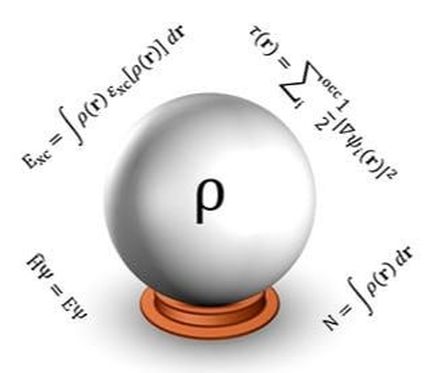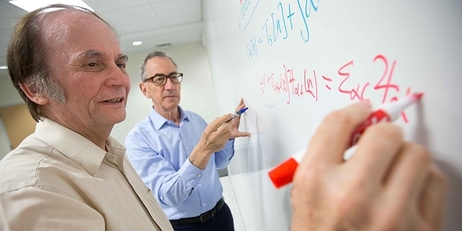CCM News
The Cori supercomputer at the National Energy Research Scientific Computing Center (NERSC) uses almost 700,000 processors to perform around 30 quadrillion (30,000,000,000,000,000) operations a second and is the size of a small warehouse! Credit: NERSC
Crunching Numbers: How supercomputers are driving superconductor research by James Furness
(Winter 2019 - Energy Frontier Research Centers' Newsletter)
If you walked the halls of the Energy Frontier Research Centers (EFRCs), you might hear a common tone: the whirring of supercomputers tirelessly running complex simulations. Supercomputers are used across the centers to study a wide variety of problems. They model spin-forbidden reactions, visualize lithium battery processes, analyze plant cell wall components, and predict the effects of radiation on materials, as well as many other things. In this article, we will dive into how researchers at one center—the Center for Complex Materials from First Principles (CCM)—are using supercomputers to help discover the electrical materials of tomorrow.
The layered structure of MoS2 is retained upon inserting the metal ions into the regions between the sheets. Adding these ions helps enhance the reduction of hydrogen ions on the surface of the MoS2 catalyst. Image courtesy of Nuwan Attanayake, Temple University
Tailoring Efficiency: The Molybdenum Disulfide Story by Emily Sahadeo
(Summer 2018 - Energy Frontier Research Centers' Newsletter)
A promising way to store energy is in the form of hydrogen fuel, which can be made through a chemical reaction which splits water molecules into hydrogen and oxygen, which are environmentally benign. At the Center for the Computational Design of Functional Layered Materials (CCDM), an Energy Frontier Research Center, experimentalists are working with theorists and studying new catalysts to help make hydrogen production more efficient and cost-effective.
"How to Find a Postdoctoral Position" Panel Discussion
(May 2018 - Temple University)
The Early Career Investigators committee of CCDM invite graduate students to attend a panel discussion about obtaining postdoctoral positions.
2017 CCDM Scholarships Awards
Celebrating the hard work of local high school seniors: Cloris Shaw-Baker, Abdelraham Mohamdy and Josue Castillo, Carver High School of Engineering and Science in Philadelphia! They all participated in the CCDM Scholarship Program and spent time in the summer working alongside distinguished CST faculty members on research projects:
Computer simulations of graphene-based layered materials for thermal applications with mentors; Michael Klein, Himanshu Chakraborty, Richard Remsing, and postdoctoral researchers in Michael Klein’s group
Producing a sustainable energy source with water with mentors; Daniel Strongin, Elizabeth Cerkez, Farbod Alimohammadi, Ph.D students in Daniel Strongin’s lab
Synthesis and characterization of novel layered materials for energy applications with mentors; Michael Zdilla, Ravneet Kaur Bhullar, postdoctoral researchers in Michael Zdilla’s lab
Energy Frontier Research Centers Booklet
(July 2017 - U.S. Department of Energy)
2017 ERCD, Hub, and CMS Principal Investigators' Meeting
SCAN Density Functional Workshop: Fundamentals, Practices and Extensions
(May 2017 - Temple University)
Experimental and Computational Approaches to Understanding Aqueous Interfaces Workshop
(March 2017 - Temple University)
The Dance of the Electrons and the Scientist
Winner of the Sound ⋂ Science Podcast Contest Best Science Music Composition
(2017 - EFRC-Hub-CMS PI Meeting and Energy Frontier Research Center's Community Website)
The first half of the piece takes a walk through the world of the electrons, as predicted by quantum theory. We use sound waves controlled by the electron energies to interpret the crystal, with echoes marking the passing high symmetry points. The second half of the piece moves the theory into the lab, imagining the growing of our superconducting crystal from sounds recorded by researchers inside a working lab.
reators: James W. Furness, Samantha L. Shumlas (laboratory recordings). With thanks to Michael J. Zdilla and Adele Ruosi for invaluable feedback and support.
Annual Meeting
(2017 - Temple University)
New Findings Boost Promise of Molybdenum Sulfide for Hydrogen Catalysis
(December 2016 - Energy Frontier Research Centers' University Research News and North Carolina State University News)
Researchers from North Carolina State University, Duke University and Brookhaven National Laboratory have found that molybdenum sulfide (MoS2) holds more promise than previously thought as a catalyst for producing hydrogen to use as a clean energy source (JACS, 2016).
Courtesy of Kristin Manke, EFRC Newsletter editor-in-chief
The CCDM is featured in Transforming Equations into Materials by Manuel A. Ortuño
(Fall 2016 - Energy Frontier Research Centers' Newsletter)
Imagine how handy it would be to have a magic crystal ball to answer any questions we might have. With the proper equations, we can similarly use computers to predict the properties of any given molecule or solid—existing or yet to be prepared. Researchers at two Energy Frontier Research Centers (EFRCs), the Center for the Computational Design of Functional Layered Materials (CCDM) and the Inorganometallic Catalyst Design Center (ICDC), have made enormous progress in developing new and efficient ways to accurately describe molecules and materials.
Courtesy of Kristin Manke, EFRC Newsletter editor-in-chief
The Metamorphosis of Metastable Metal Nitrides by Ian McKendry, CCDM member of the EFRC Newsletter Editorial Board
(Fall 2016 - Energy Frontier Research Centers' Newsletter)
Imagine yourself and a group of friends on a ski trip. While making your way down the mountain, your ski group decides to stop half way down the slope to take a break and have lunch instead of finishing the run and resting in the cozy ski lodge. This strange group is representative of an exciting class of materials called metastable metal nitrides being explored by scientists at the Center for Next Generation of Materials by Design: Incorporating Metastability (CNGMD) and Energy Frontier Research in Extreme Environments (EFree), two Energy Frontiers Research Centers (EFRCs).
Energy Frontier Research Centers Booklet
(September 2016 - U.S. Department of Energy)
Energy Frontier Research Centers Booklet, Technical Summaries
(August 2016 - U.S. Department of Energy)
Courtesy of EFRC' Newsletter Editorial Board
Electrical Conductivity Control Through Mechanical Bending, First Principles Calculations Assist in New Materials Design by Eva Zarkadoula
(August 2016 - Energy Frontier Research Centers' Newsletter)
The use of 2D materials in clean energy technologies has been one of the research interests of the Center for Computational Design of Functional Layered Materials (CCDM), an Energy Frontier Research Center at Temple University. Some of the latest findings of Liping Yu, Adrienn Ruzsinszky, and John Perdew on 2D materials research connect the mechanical bending of the materials to their electrical properties by using first principles calculations
According to their simulations, the enhanced electric polarization occurs because the interface induces the four structural changes shown at right. At left, a transmission electron microscopy image shows the atom positions in a superlattice of CaTiO3CaTiO3 and BaTiO3BaTiO3, which agree with the positions predicted in the researchers' simulations.
Viewpoint: When One Plus One is More than Two by Javier Junquera
(March 2016 - Physics (9) 28)
Dr. Xifan Wu and colleagues simulated the structure of the interface between two perovskite oxides, CaTiO3CaTiO3 and BaTiO3BaTiO3, and showed it could have a higher spontaneous electric polarization (ferroelectricity) than either material on its own.
Annual Meeting
(2016 - Temple University)
Laura H. Carnell Professor of Physics and Chemistry
ohn Perdew (left) is among an elite group of researchers and inventors to be honored with a Scott Award. Photo: Ryan S. Brandenberg
Perdew wins prestigious John Scott Award by Greg Fornia
(November 2015 - Temple's News)
Marie Curie, Thomas Edison, R. Buckminster Fuller, Jonas Salk and Nikola Tesla; these are just a few of the legendary researchers and inventors who received The John Scott Award for contributing to the “comfort, welfare and happiness” of humankind.
This year, John Perdew, Laura H. Carnell Professor of Physics and Chemistry, joins this illustrious group for his groundbreaking role in the development of density functional theory, a computational modeling method used in physics, chemistry and materials science to investigate the structure of atoms, molecules, crystals, surfaces and their interactions.
At Energy Frontiers Research Centers across the country, scientists are focused on the basic science needed to improve solar energy technologies to provide energy to heat our homes and power our industries.
The CCDM is featured in Powering the Future with Solar Energy by Sameer Patwardhan
(August 2015 - Energy Frontier Research Centers' Newsletter)
As our energy demands continue to grow along with looming global climate change, there is an imminent need to replace fossil fuels with sustainable and clean sources of energy. Solar energy has been recognized as the most prominent source for future needs. Consequently, about half of the 32 Energy Frontiers Research Centers (EFRCs) are focused on understanding and exploiting fundamental science to improve solar energy technologies. In this feature, we will review the unique approaches taken by different EFRCs and highlight several recent achievements.
New virtual form of Carbon Could Speed up Electronics by Bruce Beans
(July 2015 - Temple's News)
Chemists from the College of Science and Technology's Center for the Computational Design of Functional Layered Materials (Prof. Eric Borguet) in collaboration with researchers at Northwestern University and the University of Toulouse in France, have shown that a two-dimensional form of carbon has the potential to significantly speed up computers and other electronic devices (Nature Communication).
C.N.R. RAO, Jawaharlal Nehru Centre for Advanced Scientific Research (India) Solid-state and materials chemistry, a Presidential Visiting Scholar at Temple University
(February 2015 - Temple's News)
Prof. David Srolovitz elected to the National Academy of Engineering
(February 2015 - Material Today's News)
Professor David Srolovitz, Joseph Bordogna Professor from the Department of Materials Science and Engineering at the University of Pennsylvania, has been elected to the national Academy of Engineering.
New members are elected annually by existing members, in recognition to their outstanding research achievements. Prof. Srolovitz develops and applies theoretical approaches to explain the relationship between a material’s microstructure and its physical properties, with a particular the role of structural defects. His expertise spans a breadth of computational modeling techniques, including quantum and atomistic to continuum simulations, which all find home in Computational Materials Science.
Solid-State Physics Workshop: Language of Physics (February 2015 - Temple University)
Annual Meeting
(2015 - Temple University)
CCDM Kick Off Meeting
(October 2014 - Temple University)
Courtesy of Ryan S. Brandenberg
Laura H. Carnell Professor of Physics and Chemistry John Perdew (left), who will serve as director of the new center, and College of Science and Technology Dean Michael Klein, who is a co-principal investigator on the grant.
New Temple Center to Focus on Energy Applications by Preston Moretz
(July 2014 - Temple's News)
As world demand for energy rapidly expands, transforming the way energy is generated, supplied, transmitted, stored and used will be among the critical challenges facing the United States in the 21st century. To more quickly advance technologies that have potential to meet these growing energy needs, the Department of Energy created the Energy Frontier Research Centers to support basic research that will lay the scientific groundwork to address future critical needs in energy production, storage and use.
Temple’s center, which is being funded through a four-year, $12 million DOE award, will be led by John Perdew, Laura H. Carnell Professor of Physics and Chemistry, and includes 19 principal investigators, 10 of whom are from Temple. External collaborators will include Rice University, Duke University, Princeton University, Drexel University, Northeastern University, North Carolina State University, the University of Pennsylvania, Brookhaven National Laboratory and the Jawahalal Nehru Center for Advanced Scientific Research in Bangalore India.

























